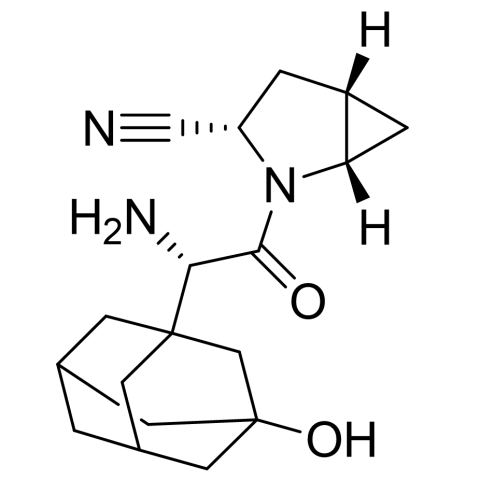Saxagliptin was developed as part of the growing interest in incretin-based therapies for type 2 diabetes, following the discovery of the role of DPP-4 enzymes in breaking down incretin hormones that regulate insulin secretion. It was developed by Bristol-Myers Squibb in collaboration with AstraZeneca, and was approved by the U.S. Food and Drug Administration (FDA) in July 2009 under the brand name Onglyza. Saxagliptin is an oral medication used to treat type 2 diabetes. It belongs to the DPP-4 inhibitor class, which works by increasing incretin hormones that help the body release more insulin and reduce blood sugar levels after meals. Usually taken once daily, it can be used alone or with other drugs like metformin. Common side effects include respiratory infections and headaches, while serious but rare risks include pancreatitis and heart failure. It’s not used for type 1 diabetes or diabetic ketoacidosis. Saxagliptin helps improve blood sugar control when combined with diet and exercise.
BRAND NAMES
Primary brand names
Onglyza: The most common brand name for saxagliptin alone.
Kombiglyze XR: A combination drug that includes saxagliptin and metformin.
Qtern: A combination drug that contains saxagliptin and dapagliflozin.
Other names
Regional and generic names: Other names, such as Zaxaglit and Saglipol, are available in different regions. These are often local or generic versions of the drug.
MECHANISM OF ACTION
Saxagliptin lowers blood sugar in people with type 2 diabetes by blocking the enzyme dipeptidyl peptidase-4 (DPP-4). This enzyme normally breaks down incretin hormones such as GLP-1 and GIP, which are released after eating. These hormones help regulate blood sugar by prompting the pancreas to release more insulin and reduce glucagon production. By inhibiting DPP-4, saxagliptin increases incretin levels, resulting in improved insulin response and lower blood glucose levels.
PHARMACOKINETICS
Absorption
Saxagliptin is quickly absorbed after oral intake, reaching peak blood levels within about 2 hours and has a bioavailability of approximately 67%. It may be taken either with or without food. The drug is metabolized mainly by the liver enzymes CYP3A4/5 into an active form known as 5-hydroxy saxagliptin. Elimination occurs through both the kidneys and liver, with around 75% of the drug excreted in urine and about 22% through feces.
Distribution
The volume of distribution (Vd) of saxagliptin is approximately 151 liters in healthy adults.
Metabolism
Saxagliptin is mainly metabolized by the cytochrome P450 enzymes CYP3A4/5 into an active metabolite called 5-hydroxy saxagliptin, which also effectively inhibits dipeptidyl peptidase-4 (DPP-4). Both the parent compound and its active metabolite are eliminated via a combination of renal and hepatic pathways, with most of the drug being excreted in the urine.
Excretion
Saxagliptin is eliminated through both renal and hepatic routes, with a large portion excreted by the kidneys; around 24% of the unchanged drug is found in the urine, and about 22% of the total dose is expelled in the feces.
PHARMACODYNAMICS
Saxagliptin works as a selective, competitive inhibitor of the enzyme dipeptidyl peptidase-4 (DPP-4). By blocking DPP-4, it prevents the degradation of incretin hormones such as glucagon-like peptide-1 (GLP-1) and glucose-dependent insulinotropic polypeptide (GIP). This results in elevated levels of active GLP-1 and GIP, which enhance glucose-dependent insulin secretion from the pancreas and reduce glucagon release, thereby improving blood sugar control in type 2 diabetes.
ADMINISTRATION
Saxagliptin is typically administered orally, once daily, with or without food. The usual dose for adults with type 2 diabetes is 5 mg per day, but the dose may be adjusted based on kidney function or in combination with other antidiabetic medications.
DOSAGE AND STRENGTH
Typical dose: 5 mg once daily
Dosage adjustments: For patients with moderate or severe renal impairment (creatinine clearance ≤50 mL/min), the recommended dose is reduced to 2.5 mg once daily.
Available strengths: Commonly available in 2.5 mg and 5 mg oral tablets.
FOOD INTERACTIONS
Saxagliptin can be taken with or without food—there are no significant food interactions affecting its absorption or effectiveness. So, you can take it anytime that fits your routine.
DRUG INTERACTIONS
Saxagliptin interacts with several drugs that can affect its metabolism and effectiveness. Strong inhibitors of the CYP3A4/5 enzymes, such as ketoconazole, clarithromycin, and ritonavir, can increase saxagliptin levels in the body, potentially raising the risk of side effects and necessitating dose adjustments. Conversely, CYP3A4/5 inducers like rifampin and carbamazepine may lower saxagliptin concentrations, reducing its therapeutic effect. When used alongside other antidiabetic agents such as insulin or sulfonylureas, there is an increased risk of hypoglycemia, so careful monitoring is advised. Additionally, strong P-glycoprotein inhibitors may also elevate saxagliptin levels. It is important to consult a healthcare provider before combining saxagliptin with other medications to manage these potential interactions safely.
CONTRAINDICATIONS
Saxagliptin is contraindicated in individuals who have a known hypersensitivity to saxagliptin or any of its ingredients. It should also be avoided in individuals with a history of pancreatitis, as it may increase the risk of this condition. Additionally, caution is advised in patients with severe renal impairment unless dosing is appropriately adjusted. Use is not recommended in type 1 diabetes or diabetic ketoacidosis. Always consult a healthcare provider before starting saxagliptin to ensure it’s safe for your specific health conditions.
SIDE EFFECTS
Common side effects:
Headache.
Upper respiratory tract infection, such as the common cold (nasopharyngitis).
Urinary tract infection (UTI).
Stomach pain, nausea, or diarrhea.
Runny or stuffy nose.
Serious side effects:
Pancreatitis.
Heart failure.
Severe joint pain.
Serious allergic reactions.
Bullous pemphigoid.
OVERDOSE
Symptoms of hypoglycemia can vary in intensity, ranging from mild to severe, and may include the following:
Neurological symptoms: Confusion, extreme weakness, dizziness, slurred speech, or seizure.
Cardiovascular symptoms: Fast heartbeat, shakiness, or tremors.
Gastrointestinal symptoms: Nausea, vomiting, diarrhea, or increased hunger.
Skin changes: Sweating or cool, pale skin.
Other symptoms: Rapid breathing or fainting.
TOXICITY
Saxagliptin is a well-tolerated medication for type 2 diabetes, with toxicity primarily associated with severe side effects and overdose. Significant risks include an increased risk of heart failure, especially in patients with pre-existing heart or kidney disease, as well as the potential for pancreatitis, severe joint pain, and serious allergic reactions.


